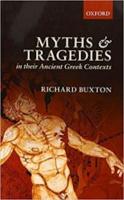
OUP (2018) p/b 304pp £25 (ISBN 9780199557615)
This paperback version of a book first published in 2013 collects revised versions of articles on myth and tragedy previously published elsewhere. Each of the articles illuminates the richness and diversity of mythological stories and story-telling. Although the articles span thirty years (and are not presented in chronological order), and explore various themes, contexts and ideas, the reading of each helps to build an understanding of the complexity, but also the richness of Greek thought as reflected in the ancients’ exploration of mythological stories.
Although its composition might suggest a piecemeal reading of each article in any order, there is much to be gained from reading through the book. B. carefully introduces the collection and each of the articles within it. He requires us to draw together not only the ancient perspectives of myth, but also modern ones. In his introduction he notes that a number of shifts has taken place, even over the past thirty years, warning against becoming constrained by idées fixes.
Even so, while inviting the reader to find in myth (and his articles) material with which ‘it is good to think’, he seeks to structure our responses by highlighting a number of approaches common within the chapters of the book. These examine structure, context, the porosity of myth, the ‘uncertainty principle’ and the importance of appreciating that in tragedy we have ‘retellings’ of myths. We are given pieces of a jigsaw for which no complete picture exists. Although B. tries to draw together the disparate parts of these studies with his short introductory prefaces to each of the chapters, the parts are not necessarily contiguous. For this reviewer this lack of cohesion does not preclude the book being more than the sum of its parts. It is the gaps in the narrative which are of most interest.
The papers in the first half of the book relate to various aspects of myth, including the literal and metaphorical liminality of horizons and mountains (chapter 1; Imaginary Greek Mountains); how ‘myth-tellers select and shape… themes and structures constitutive of the Greek imaginaire’ (chapter 2; Wolves and Werewolves in Greek Thought), and how mythological names may have significance (chapter 3—Mythological Names; the case for Melas). Concluding chapter 4 (The Myth of Talos: Vulnerability, ichor, and Boundary-Crossing) B. uses myth to exhort his readers to steer their path carefully: ‘… a student of myth is obliged ceaselessly to negotiate Skylla and Charybdis. Skylla is over-interpretation, going implausibly beyond the evidence; Charybdis is failure to register the incredible intricacy of the language of Greek myth’. Then with wry self-deprecation, aware of what he is attempting he adds: ‘…we can only follow a course set by Odysseus: avoid Charybdis at all costs, and then keep one’s heads down so as not to get them bitten off.’ In chapter 5 (Movement and Stillness: Versions of Medea) B. seeks to examine the representations of Medea in Apollonius’ Argonautika, applying cultural understandings to the text, and examining the polarities of movement and stillness as represented in Medea as ‘compulsive mover’ on the one hand and the ‘unmoved mover’ on the other (p. 71).
In the second half of the book B. turns his attention to mythology as it is ‘retold’ in tragedy, starting with more general studies (chapter 6—Tragedy and Greek Myths; chapter 8—Bafflement in Greek Tragedy), and finishing with studies which focus more closely upon individual plays (chapter 10—Euripides’ Alkestis: Five Aspects of an Interpretation, chapter 11—Feminised males in Bakchai: The Importance of Discrimination). For this reviewer it is chapter 9 (‘Blindness and Limits’—the earliest of the articles to be published), which examines the dynamism of myth both within ancient and modern thinking, and in establishing paradigms for an understanding of the same, best facilitates our thinking ‘with’ myth and about the literary texts. B. highlights certain structures, frameworks of thought and perception within which Greeks told, listened to and read mythical stories.
Each of B.’s articles deserves wide readership, but so does the book. Each of the chapters can be read alone. Each will inform, challenge, and promote fruitful reflection. Bearing in mind that each article was written at different times and for different publications, and that there is no intention that they should be combined to provide a consistent and comprehensive narrative—such is the complexity of the shifting sands of mythology—nevertheless, B.’s compilation benefits from being read as a whole. As one might, expect the book begs as many questions as it answers, but it certainly helps us to frame our responses and gives us the opportunity to think productively about myth, literature and society and our responses to them.
Simon Tremewan
